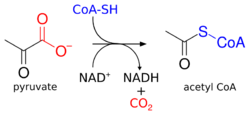Biology:Pyruvate decarboxylation

Pyruvate decarboxylation or pyruvate oxidation, also known as the link reaction (or oxidative decarboxylation of pyruvate[1]), is the conversion of pyruvate into acetyl-CoA by the enzyme complex pyruvate dehydrogenase complex.[2][3]
The reaction may be simplified as:
- Pyruvate + NAD+ + CoA → Acetyl-CoA + NADH + CO2
Pyruvate oxidation is the step that connects glycolysis and the Krebs cycle.[4] In glycolysis, a single glucose molecule (6 carbons) is split into 2 pyruvates (3 carbons each). Because of this, the link reaction occurs twice for each glucose molecule to produce a total of 2 acetyl-CoA molecules, which can then enter the Krebs cycle.
Energy-generating ions and molecules, such as amino acids and carbohydrates, enter the Krebs cycle as acetyl coenzyme A and oxidize in the cycle.[5] The pyruvate dehydrogenase complex (PDC) catalyzes the decarboxylation of pyruvate, resulting in the synthesis of acetyl-CoA, CO2, and NADH. In eukaryotes, this enzyme complex regulates pyruvate metabolism, and ensures homeostasis of glucose during absorptive and post-absorptive state metabolism.[6] As the Krebs cycle occurs in the mitochondrial matrix, the pyruvate generated during glycolysis in the cytosol is transported across the inner mitochondrial membrane by a pyruvate carrier under aerobic conditions.[citation needed]
References
- ↑ "Oxidative decarboxylation of Pyruvate" (in en-US). 2018-07-29. https://www.biosciencenotes.com/oxidative-decarboxylation-of-pyruvate/.
- ↑ "Pyruvate oxidation". https://www.khanacademy.org/science/biology/cellular-respiration-and-fermentation/pyruvate-oxidation-and-the-citric-acid-cycle/a/pyruvate-oxidation. Retrieved 25 January 2018.
- ↑ "Pyruvate Oxidation". http://oregonstate.edu/instruct/bb451/winter08/lectures/citricacidcycle.html. Retrieved 25 January 2018.
- ↑ Trifiletti, R. R. (2014-01-01), Aminoff, Michael J.; Daroff, Robert B., eds. (in en), Thiamine (Vitamin B1) and Beri-Beri, Oxford: Academic Press, pp. 445–447, doi:10.1016/b978-0-12-385157-4.00116-0, ISBN 978-0-12-385158-1, http://www.sciencedirect.com/science/article/pii/B9780123851574001160, retrieved 2020-11-16
- ↑ Stryer, Lubert; Tymoczko, John L.; Berg, Jeremy M. (2002). "The Citric Acid Cycle" (in en). Biochemistry. 5th Edition. https://www.ncbi.nlm.nih.gov/books/NBK21163/.
- ↑ Jordan, Frank; Furey, William; Nemeria, Natalia S.; Patel, Mulchand S. (2014-06-13). "The Pyruvate Dehydrogenase Complexes: Structure-based Function and Regulation" (in en). Journal of Biological Chemistry 289 (24): 16615–16623. doi:10.1074/jbc.R114.563148. ISSN 1083-351X. PMID 24798336. PMC 4059105. http://www.jbc.org/content/289/24/16615.
 |

